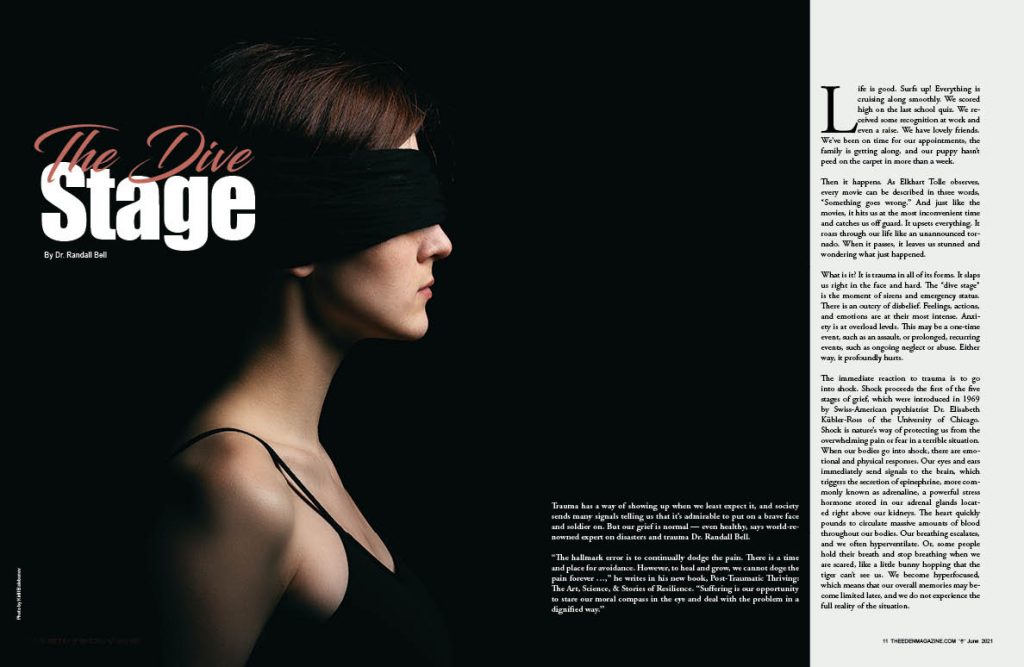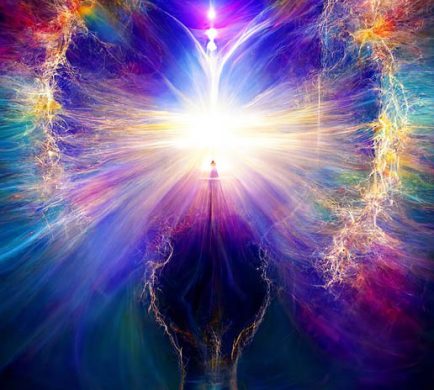By Randall Bell
Life is good. Surfs up! Everything is cruising along smoothly. We scored high on the last school quiz. We received some recognition at work and even a raise. We have lovely friends. We’ve been on time for our appointments, the family is getting along, and our puppy hasn’t peed on the carpet in more than a week.
Then it happens. As Elkhart Tolle observes, every movie can be described in three words, “Something goes wrong.” And just like the movies, it hits us at the most inconvenient time and catches us off guard. It upsets everything. It roars through our life like an unannounced tornado. When it passes, it leaves us stunned and wondering what just happened.
What is it? It is trauma in all of its forms. It slaps us right in the face and hard. The “dive stage” is the moment of sirens and emergency status. There is an outcry of disbelief. Feelings, actions, and emotions are at their most intense.
nxiety is at overload levels. This may be a one-time event, such as an assault, or prolonged, recurring events, such as ongoing neglect or abuse. Either way, it profoundly hurts.
The immediate reaction to trauma is to go into shock. Shock proceeds the first of the five stages of grief, which were introduced in 1969 by Swiss-American psychiatrist Dr. Elisabeth Kübler-Ross of the University of Chicago. Shock is nature’s way of protecting us from the overwhelming pain or fear in a terrible situation. When our bodies go into shock, there are emotional and physical responses. Our eyes and ears immediately send signals to the brain, which triggers the secretion of epinephrine, more commonly known as adrenaline, a powerful stress hormone stored in our adrenal glands located right above our kidneys. The heart quickly pounds to circulate massive amounts of blood throughout our bodies. Our breathing escalates, and we often hyperventilate. Or, some people hold their breath and stop breathing when we are scared, like a little bunny hopping that the tiger can’t see us. We become hyperfocused, which means that our overall memories may become limited later, and we do not experience the full reality of the situation.
As babies, we had what is called a “reptilian” or instinctual brain. We just eat, sleep, and poop. As we grow, so does our brain. Our limbic, or “mammal brain comes next, and then finally, our cortex or rational human brain develops. Yet this inner “reptilian” core always remains and continues to regulate our most basic instincts. During trauma, it kicks into gear. People usually first call for help, and then we can go into a fight-flight-freeze stage, where any of these options become very real. Trauma directly and measurably impacts the brain. Trauma affects our ability to think clearly.
In shock, our minds become somewhat numb, foggy, and disconnected from reality. It is almost as if we are watching a movie or having an out-of-body experience. The blood supply is being diverted to the muscles to fight or run, and the objective centers on mere survival. We may feel nauseous, anxious, and our muscles and chest can feel tight. We can feel rage, intense anger, or the urge to scream. Some find superhuman strength.
In this state of traumatic shock, we are often overcome with an overwhelming feeling of disbelief and paralysis to the core. This surge of adrenalin is nature’s way to numb the pain and help us survive and get to a safe place. Many of us have experienced an electrical blackout, where the power grid is overloaded, the circuit breaker trips, or the fuses burn out. Televisions, computers, refrigerators, and electric clocks all shut down. When trauma overloads our brains and emotional systems, a similar phenomenon occurs. Normal operations shut down. Often people feel as if they are “looking at themselves from the outside.” The human brain physiologically performs far differently under these conditions. Shock is not in one’s imagination. Shock is real.
Unresolved Trauma
Unresolved trauma is the most significant problem facing humankind. Our present stress is from our unsettled trauma. When trauma hits, the most critical decision we make is to choose whether to be a victim, aggressor, survivor, or thriver. By college age, up to 85% of us have been impacted by at least one trauma. In all its forms, trauma shatters our reality. Perhaps with Covid-19, even more, they feel they have been traumatized. It smashes our life’s assumptions and turns our world upside down. Our past traumas are impacting our current state of mind and the relationships of those we love. Ultimately, the quality of our lives, family, career, and community depends on our ability to process trauma successfully.
Today we see crime, alcoholism, drugs, anger, anxiety, abuse, and violence everywhere. Recovery centers are packed with patients. Extremist political and religious groups regularly trap more members. Jails and prisons are jammed on an industrial scale.
As dangerous as these are, they are all secondary problems. The common issue underlying each of these conditions is unresolved trauma. Addictions, fanatical extremes, workaholism, and mass incarceration are just the symptoms.
Anger, guilt, cynicism, self-righteousness, greed, and anxiety are all secondary reactions. Anger gives you a feeling of power and produces adrenaline, which is physiologically addictive. Violence, aggression, shaming, and rage are ancillary emotions. Scores of people self-medicate in an attempt to numb the pain and shield themselves from harsh realities. Yet, despite these efforts to dull the pain, many of us continue to wallow in our misery.
We may or may not be responsible for our trauma, but we are responsible for our healing. When we focus on and address unresolved trauma, we gradually replace “self-medication” with “self-care.” It is a messy process, and sometimes it feels like the directions say to rinse and repeat. At times we take one step forward and two steps back. But we keep going. If we unlock the secret of healing from unprocessed trauma, we can heal our world, nation, families, and ourselves.
It is a tall order. Still, the field of psychology, physiology, and social sciences have become so advanced that we now have the verifiable and measurable research that brings authentic solutions. We understand brain chemistry. We can heal and have peace. We can repair the world, and at a minimum, we can change our world. We can achieve post-traumatic thriving.
Trauma and the Brain
Our body’s brain functions, nervous system, and chemistry are remarkably complex; however, when it comes to trauma, it is helpful to understand some fundamentals. Our central brain’s physiology includes hormones, endorphins, and neurotransmitters, or “HEN’s.”
The interactions of these hormones, endorphins, and neurotransmitters regulate emotions widely, ranging from rage to bliss. There are about 50 hormones, which are primarily stored in eight major glands and secreted into our bloodstream. There are also over 20 endorphins, which are chemicals mainly stored in the pituitary gland and secreted into our bloodstream. Finally, there are over 40 neurotransmitters, which are chemicals stored along with our nervous system and released by nerve impulses.
Trauma involves four significant categories of HEN’s, and by using the acronym SODA, they are easy to remember. SODA stands for Serotonin, Oxytocin, Dopamine, and Adrenaline. Serotonin is related to well-being. It is a neurotransmitter released by various activities, such as eating certain foods, exercise, meditation, massage, sleep, laughter, and music.
Oxytocin is a hormone associated with a feeling of love and social bonding. This “cuddle” hormone is released by the pituitary gland when people snuggle or connect socially. Dopamine is a pleasure-related hormone regulated by the hypothalamus, located at the base of the brain, near the pituitary gland. It is released during pleasurable situations such as food, sex, and certain drugs—feelings of happiness result from a mix of serotonin, oxytocin, dopamine, and endorphins. A key to healing is to understand that specific activity is proven to result in these chemical releases. This is not wishful thinking. This is science.
Adrenaline and cortisol are released when we play sports or exercise. Strong emotions such as fear or anger cause the brain’s medulla to send a message to the adrenal gland, which is located above the kidneys and releases adrenaline into the bloodstream. Adrenaline is a hormone that causes an increase in heart rate, muscle strength, blood pressure, and sugar metabolism. This is what produces the classic fight-flight-freeze reaction.
In ordinary life, our brains encode the information, send it down an established pathway, process it, and store the experience as a narrative, or story, at some level in our memories. Our brains are always alert with a variety of routine chemical, electrical, and neurological impulses during a typical day. These impulses tell us to do that, pay more attention here, and forget there. Under normal circumstances, the only messages are those that need attention. We are mindful, fully aware, and mentally present. When our brains are in this mode, we are merely processing specific facts, figures, details, and realities. Our outer brain cortex is busy processing our senses, logic, and facts. Generally, in our “mammal” midbrain, we process our emotions. We work and have fun. Life goes on.
When trauma hits, brain activities change—the focus shifts to our inner “reptilian” brain that is responsible for our most basic instincts. Indeed, our brains shift from routine and normal pathways. Facts, standard memory, and general knowledge are pushed away, and a flood of high emotion and sensations take over. Powerful chemicals and hormones are pumped directly into our bloodstreams, both by our brains and some of the eight main glands located throughout our bodies.
To survive, our brains turn down rational, explicit decision-making and switch to implicit emotions. In other words, we switch from an ordinary, logical world to a world of raw instinct. Sensing danger, our brains tell us to run, freeze, or fight like hell.
In this state of shock, our memories can be distorted. This is fundamental in understanding the healing process. We first react to trauma with shock because it is impossible to wrap our heads around the situation. It is simply overwhelming. If we see an accident, we are so stunned that we freeze on the spot with our mouths hanging open and our eyes wide. If we are in the accident, we are paralyzed even further.
Our normal thought processes are put on hold, and we cannot fathom what is going on. Some people recover quickly and take action. Others stay frozen.
Because we “simply cannot believe it,” we may shut down. We may dodge discussions of the topic and repress the thought so profoundly that we cannot recall it later. Since our brains did not normally perform during the trauma, the information was not customarily processed and stored.
Our memory of the experience is fragmented, repressed, for gotten, or just scrambled up. Consequently, rather than store the information and move on, our brains may continue to send mixed signals that we are still in danger. In an attempt to protect us movingforward, our senses continuouslyscan our surroundingslooking for any slight similarity to the traumatic situation.
We become hypervigilant to prevent the trauma from happening again, even though we may no longer be in any actual danger.
Specific triggers can bring out the trauma all over again. Particular words, images, smells, or experiences can set off the amygdala within our brain, which secretes hormones and triggers adrenalin as if the trauma were occurring again. Our heart rate races, we sweat, our breathing speeds up or freezes up, and our muscles tense to get ready to fight or run.
Exposure to an event may not be traumatic to one person but can cause trauma to another. What hits the core of one person may be shrugged off by someone else. Some are inherently more or less prone to the lasting effects of trauma. We all handle tragedy differently. Your trauma is valid. Everybody’s hurt legitimate.







